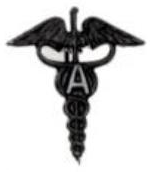
The 92nd Infantry Division was an African-American infantry division of the United States Army that served in both World War I and World War II. The military was then segregated. The division was organized in October 1917, after the U.S. entry into World War I, at Camp Funston, Kansas, with African-American soldiers from all states. In 1918, before leaving for France, the American buffalo was selected as the divisional insignia due to the "Buffalo Soldiers" nickname, given to African-American cavalrymen in the 19th century. The divisional nickname, "Buffalo Soldiers Division", was inherited from the 366th Infantry, one of the first units organized in the division.

The 27th Infantry Division was a unit of the Army National Guard in World War I and World War II. The division traces its history from the New York Division, formed originally in 1908. The 6th Division designation was changed to the 27th Division in July 1917.

The Army Medical Department of the U.S. Army (AMEDD), formerly known as the Army Medical Service (AMS), encompasses the Army's six medical Special Branches. It was established as the "Army Hospital" in July of 1775 to coordinate the medical care required by the Continental Army during the Revolutionary War. The AMEDD is led by the Surgeon General of the U.S. Army, a lieutenant general.
The 22nd Division was an infantry division of the British Army during World War I, raised in September 1914, from men volunteering for Lord Kitchener's New Armies. The division moved to France in September 1915, but it was transferred to Greece only one month later. It served in the Balkans Campaign for the duration of the First World War.

The Surgeon General of the United States Army is the senior-most officer of the U.S. Army Medical Department (AMEDD). By policy, the Surgeon General (TSG) serves as Commanding General, U.S. Army Medical Command (MEDCOM) as well as head of the AMEDD. The surgeon general's office and staff are known as the Office of the Surgeon General (OTSG) and are located in Falls Church, Virginia.

The 57th Division was an infantry formation of the Territorial Force created in 1914 as part of the massive expansion of the British Army during the First World War. It served on the Western Front during 1917 and 1918. The divisional number was reactivated for deception purposes during the Second World War.
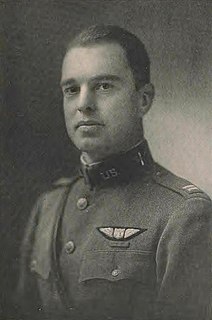
Walter Lovell was a World War I volunteer pilot and an American serviceman. He was born in Newton, Massachusetts, to Wallace D. and Josephine (Hastings) Lowell. Walter attended Newton High School and graduated from Harvard College with a Bachelor of Arts degree, class of 1907. He stayed in Boston and went into brokerage business after graduation.

75th Division was an infantry division of the British Army in World War I. It was raised in the field by the Egyptian Expeditionary Force (EEF) in 1917 and it included British, Indian and South African troops. It served in the Middle East during the Sinai and Palestine Campaign being involved in the Battles of Megiddo.

The 24th Aero Squadron was a United States Army Air Service unit that fought on the Western Front during World War I.

Camp Crane was a World War I United States Army Ambulance Service (USAAS) training camp, located in Allentown, Pennsylvania. Its mission was to train ambulance drivers to evacuate casualties on the Western Front in France. It was named for Brigadier General Charles Henry Crane, surgeon general of the Army in 1882-83.
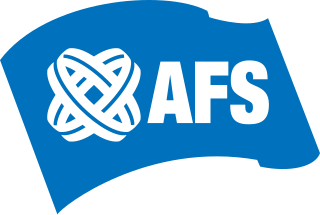
AFS Intercultural Programs is an international youth exchange organization. It consists of over 50 independent, not-for-profit organizations, each with its own network of volunteers, professionally staffed offices, volunteer board of directors and website. In 2015, 12,578 students traveled abroad on an AFS cultural exchange program, between 99 countries. The U.S.-based partner, AFS-USA, sends more than 1,100 U.S. students abroad and places international students with more than 2,300 U.S. families each year. More than 424,000 people have gone abroad with AFS and over 100,000 former AFS students live in the U.S.
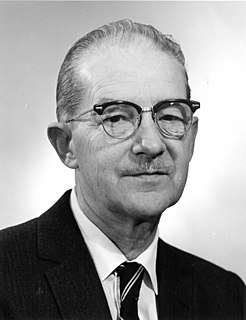
Frederick Clever Bald was a teacher and authority on early Michigan history and served as director of the Bentley Historical Library at the University of Michigan. Following service in France with an ambulance unit during World War I, Bald completed his college education and embarked on a teaching career in Detroit, Michigan before returning to graduate school to study the history of the Northwest Territory. The subject of his dissertation was Detroit during its first decade under American occupation, subsequently published as Detroit's First American Decade 1796 to 1805. Bald also authored the book Michigan in Four Centuries as well as numerous articles. During World War II, Bald was appointed University War Historian at the University of Michigan, beginning his affiliation with the Michigan Historical Collections, forerunner of the Bentley Historical Library. He served as director of the Michigan Historical Collections from 1960 to 1966.
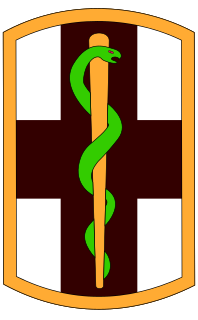
The 1st Medical Brigade is a medical brigade of the United States Army. It is located at Fort Hood, Texas, providing health care and medical services to the Fort Hood community, and continuing training in its combat support mission.

Base Hospital No. 20, located in Châtel-Guyon, France, was one of the hundreds of Base Hospitals created to treat soldiers, wounded during the First World War. It was created in 1916 by the University of Pennsylvania and served the American Expeditionary Forces (A.E.F.) until 1919.

Base Hospital No. 5 was organized by Harvard University and was one of six American Expeditionary Forces (AEF) Base Hospitals loaned to the British Expeditionary Forces (BEF) during the First World War. The personnel started in Camiers at General Hospital No. 11 in June 1917 and then moved to General Hospital No. 13, at Boulogne-sur-Mer to finish out the war.

American Base Hospital No. 57 was an American military hospital formed in Georgia, United States. During the First World War the hospital moved to Paris, where a 1,800-bed hospital was set up to deal with war casualties.

American Base Hospital No. 1 was an American military hospital formed in Bellevue Hospital, New York City, United States. During the First World War the hospital moved to Vichy, France where it was set up to deal with war casualties.
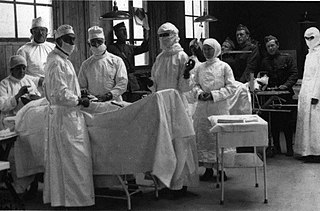
American Base Hospital No. 116 was an American military hospital formed in New York City, United States. During the First World War the hospital moved to Bazoilles-sur-Meuse, Department Vosges, in the advance section, France where it was set up to deal with war casualties.

Loy McAfee was an American surgeon, bibliographer, editor.
